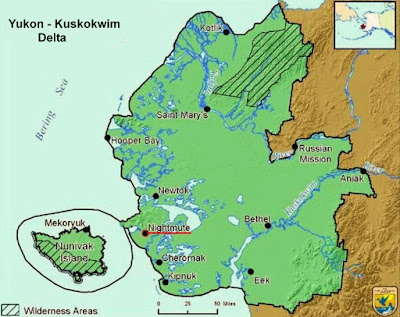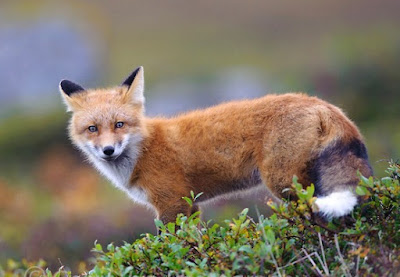Nightmute (Negtemiut in Yup'ik) is a village north of the Kuskokwim Delta, on Nelson Island, and on the banks of the Ninglick river - a canal in fact, between the island and mainland. This is tundra territory, patched by several winding arms of water and lakes.
Coordinates: 60° 29' N, 164° 49' W
Population: ~ 280
The nearest settlement is Chefornak, to the south, and it's already been on a post at U.T. here.
There are no practicable roads. Nightmute can be reached by snowmobile or Bush flying, and in summer by boat along the rivers and canals.
The main buildings in town - the School, the Community Center.
Housing for teachers.
The village has no streets - the wet terrain doesn't allow. The houses are connected by wooden boardwalks.
Most residents are Yup'ik natives, living a traditional subsistence lifestyle of hunting, fishing, and gathering. Fishing for salmon and whitefish provides a staple of the Yup'ik diet along the river.
There is a community center, health clinic and most important of all there is a school, the center of local life.
As other native american communities, Yup'ik eskimos are skilled at making refined grass baskets:
These are at the local Elitnaurviat School's exhibition.
This was made by Theresa George.
Yup'ik artist Jane Wiseman was born in Nelson Island.
The Community Service Center, where most cultural life and leisure takes place.
The Yukon–Kuskokwim Delta National Wildlife Refuge
The Wildlife Refuge is located where the Yukon and Kuskokwim rivers empty into the Bering Sea on the west coast of Alaska.
Nightmute, by the Ningaluk (Ningliq) river, is surrounded by water canals and puddles.
This is one of the largest deltas in the world, larger than the Mississippi Delta. Consisting mostly of tundra, the area is protected as part of the Yukon Delta National Wildlife Refuge.
Kuskokwim Delta.
The river's name comes from the Yup'ik kusquqviim, recorded by a Russian sailor in 1826. The principal economic activities along the river have historically been fur trapping and fishing.
Besides the tundra vegetation, the Refuge is home to foxes, bears, salmon-family fish and many bird species:
Cackling Goose
Bristle-thighed curlew
Red fox
------------------------
Nightmute is, alas, a poorly developed settlement. It's sad to say but it's true: the U.S. doesn't care and protect its native peoples as Canada does; the Nunavut and Northwest Territories native settlements benefit largely more from civilization´s comfort than their Alaskan counterparts.


























